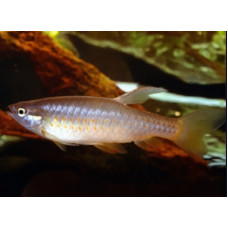Latin name
Pyrrhulina filamentosa
Other name
Papua Fish
Identification
Pyrrhulina filamentosa has an elongated body with a large caudal fin, the upper lobe of which is noticeably longer than the lower.
Features of Fish Fins
This species possesses dorsal, caudal, and anal fins. They are distinguished by long, splayed filaments on their pectoral fins, which create an appearance of leaves floating in the water. The length of these filaments can be 1.5 times the body length and are used for camouflage among aquatic plants to protect against predators.
Fish Coloration
The base coloration is gray-silvery with a dark back. Pinkish hues may be present. A faint black stripe runs along the body, starting at the head. Males, unlike females, have a reddish-black dorsal fin.
Distribution
Found in South America: in coastal rivers between the mouth of the Amazon River and the Orinoco.
Habitat
This is a freshwater benthopelagic fish, preferring a tropical climate (23°C–28°C). They are typically collected in small streams and backwaters.
Size
Males reach 8.5 cm in total length. Maximum length: 11.1 cm; maximum published weight: 11.90 g.
Behavior
They are often found in shallow streams with slow currents alongside Copella carsevennensis and various Rivulus species. They are generally solitary and territorial. They are considered calm fish, despite frequently jumping out of the water.
Food and Feeding Habits
Omnivorous. Terrestrial insects that fall into the water constitute a significant part of their diet.
Reproduction
Pyrrhulina filamentosa deposits its eggs on the undersides of emergent leaves. In an aquarium, spawning occurs as follows: prepared to spawn, the male and female jump out of the water and adhere their abdomens to the glass. After hanging there for several seconds and laying a clutch of about a dozen eggs on the glass, the fish fall back into the water. After about fifteen minutes, they jump out again and lay a new batch of eggs nearby. These jumps are repeated up to 15-20 times. After spawning is complete, a coin-sized clutch of eggs remains on the glass above the water line. The male, by slapping his tail, splashes water onto the clutch to keep it moist. After two or three days, the larvae hatch. Soon after, they begin to swim freely.
Fishing
This species is not commercially important.
Relationship with a person
Harmless. Used in aquariums.
| Classification | |
| Phylum | Chordata |
| Class | Actinopterygii |
| Squad | Characiformes |
| Family | Lebiasinidae |
| Genus | Pyrrhulina |
| Species | P. filamentosa |
| Features | |
| Conservation status | Least Concern |
| Habitat | Pelagic |
| Life span, years | No information |
| Maximum body weight, kg | 0,0119 |
| Maximum length, cm | 11,1 |
| Sailing speed, m/s | No information |
| Threat to people | Not edible |
| Way of eating | Planktonophage |
Pyrrhulina filamentosa
Tags: pyrrhulina filamentosa

